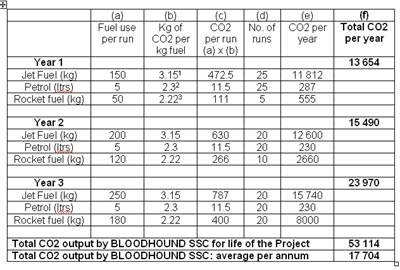Background
The BLOODHOUND Project is largely a virtual company, with a small design office in Bristol. The majority of the staff work from their homes and do not commute.
The BLOODHOUND Project will be able to teach, demonstrate and build understanding of the careful use and management of energy. If it is to achieve its target speed, the BLOODHOUND SSC vehicle will be have to be the most fuel-efficient Mach 1.4 manned vehicle.
The Bloodhound vehicle is powered by two power plants:
• A EuroJet EJ200 jet engine as used in the Typhoon aircraft. The EJ200 is one of the smallest and most powerful military engines of its type. The engine burns small volumes of standard jet fuel, as used in commercial airliners. BLOODHOUND SSC will use a maximum of 200-250 kg of jet fuel on its high speed runs.
• The other power plant is a hybrid rocket motor, which is used for a very short burn time (20secs) to accelerate the car to its peak speed. The fuel pump for the rocket motor is driven by an V-8 petrol engine and, given the short duration of the rocket burn, it is unlikely that the V-8 will burn more than 5 litres of petrol per run.
• The rocket motor uses High Test Peroxide (HTP) as the oxidiser and HTPB, an aromatic rubber substance, as the fuel. The rocket will be used for many of the early runs using peroxide alone as a monopropellant, which decomposes to produce steam and oxygen (up to 230 kilogrammes of oxygen per run) and no CO2 emissions.
• During later high speed runs the rocket will burn most of the 180 kg of HTPB and generate up to 400kg of CO2 for each run.
Forecast output for BLOODHOUND SSC
Based on past experience the car would be expected to make just 20-25 runs, each calendar year. The development of the vehicle up to its maximum speed may take up to a maximum of 3 years. The test programme is planned along the following lines:
Year 1 – 25 low/medium speed (up to 800 mph) runs
Jet fuel: 150 kg per run
Petrol: 5 litres per run
Rocket fuel: 20 monopropellant runs (no CO2), 5 short test burns of 50 kg per run
Year 2 – 20 high speed (up to 900 mph) runs
Jet fuel: 200 kg per run
Petrol: 5 litres per run
Rocket fuel: 10 monopropellant runs and 10 hybrid runs at up to 120 kg fuel per run
Year 3 – 20 high speed (working up to 1000 mph) runs
Jet fuel: 250 kg per run
Petrol: 5 litres per run
Rocket fuel: up to 180 kg per run

Some comparisons
An average car:
• emits 170g CO2 per km [4].
• would produce 17,704 kg CO2 by driving 104,141 km or 64,684 miles.
BLOODHOUND SSC’s annual CO2 output is the equivalent of driving 64,684 miles in an average car.
A lactating cow:
• produces over 6000 litres of CO2 per day [5], or 6000 x 365 = 2,190,000 litres per year.
• CO2 weighs 0.00196 kg per litre, so the cow’s output is 2,190,000 litres x 0.00196 = 4,292kg CO2 per year.
• BLOODHOUND SSC’s annual CO2 of 17,704 output is equivalent to 17,704/4292 = 4.12 cows.
BLOODHOUND SSC’s annual CO2 output is equivalent to that of 4.12 cows.
Additional considerations
The above assessment only addresses the CO2 output of the BLOODHOUND SSC when it is running. It does not take into account the CO2 produced to transport the Car, equipment, and team to the test location, or the environmental effects of the media and spectators present. However, the BLOODHOUND team is considerably smaller than, for example, a Formula One team. BLOODHOUND uses a comparable amount of support equipment and is likely to attract a smaller on-site media and spectator footprint, instead maximising the power of modern digital communications to enjoy a huge global audience without environmental travel costs.
For each overseas F1 race, 11 teams each larger than BLOODHOUND will produce a spectacle that will last for only one weekend, before they move on. By comparison, BLOODHOUND SSC will provide a global spectacle for three years, with historically demonstrated longevity long after the Project has completed. If BLOODHOUND achieves its aim of inspiring a new generation of engineers, who will in turn build the high-technology, energy efficient, low-carbon world of the future, then BLOODHOUND SSC will have achieved a huge environmental saving.
Andy Green
17 October 2008
(based on an original paper by Richard Noble)
References:
[1] and [2] http://www.defra.gov.uk/environment/business/reporting/pdf/conversion-factors.pdf
[3] Agreed figures, based on test firings of original BLOODHOUND rocket system (Falcon)
[4] http://www.dft.gov.uk/consultations/archive/2006/reducingnewcarco2emissions/reducingnewcarco2emissionswh1748?page=2
[5] http://jds.fass.org/cgi/content/abstract/78/12/2760

